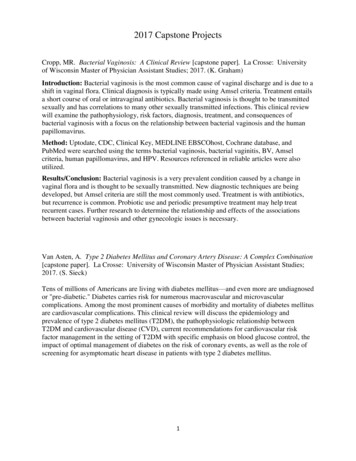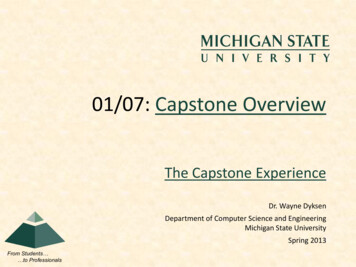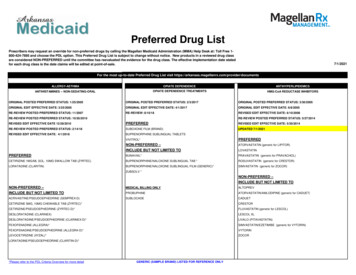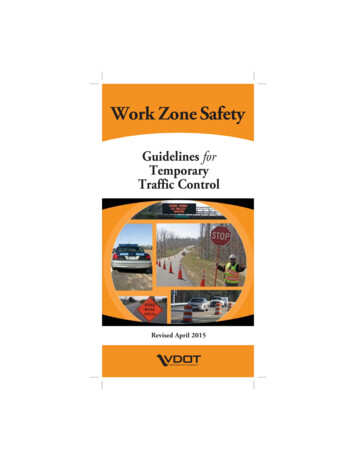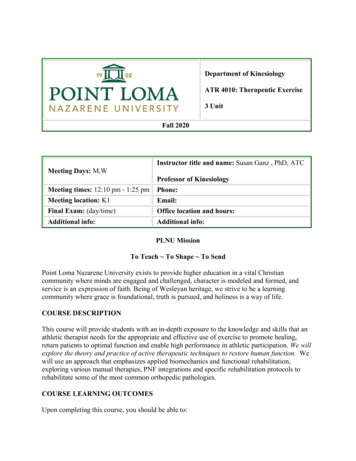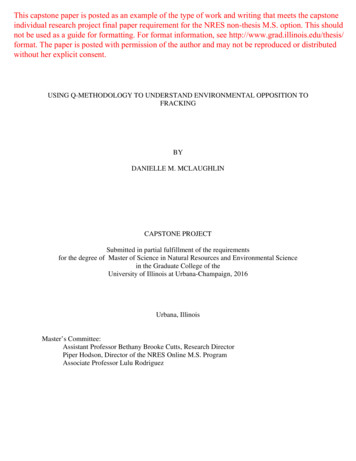
Transcription
This capstone paper is posted as an example of the type of work and writing that meets the capstoneindividual research project final paper requirement for the NRES non-thesis M.S. option. This shouldnot be used as a guide for formatting. For format information, see http://www.grad.illinois.edu/thesis/format. The paper is posted with permission of the author and may not be reproduced or distributedwithout her explicit consent.USING Q-METHODOLOGY TO UNDERSTAND ENVIRONMENTAL OPPOSITION TOFRACKINGBYDANIELLE M. MCLAUGHLINCAPSTONE PROJECTSubmitted in partial fulfillment of the requirementsfor the degree of Master of Science in Natural Resources and Environmental Sciencein the Graduate College of theUniversity of Illinois at Urbana-Champaign, 2016Urbana, IllinoisMaster’s Committee:Assistant Professor Bethany Brooke Cutts, Research DirectorPiper Hodson, Director of the NRES Online M.S. ProgramAssociate Professor Lulu Rodriguez
ABSTRACTThe recent expansion in the development of unconventional sources of natural gas in the UnitedStates, specifically the Marcellus Shale-rich state of Pennsylvania, has generated policy and publiccontroversy. The media discourse about fracking in central Westmoreland County has often beennegative, based on media coverage, newspaper articles, and the development of numerousopposition groups. This study uses Q-methodology to examine emergent perspectives and subdiscourses within the fracking opposition debate in central Westmoreland County, PA. Theanalysis reveals four different narratives of perspectives amongst people actively involved inlocally opposing fracking, labeled (1) Future Fears; (2) Local Resistor (3) Community Concerns;and (4) Distrust Stakeholders and Turn towards Renewables. The conflicts that emerge acrossthese four extracted factors are indicative of deeper discourse within the fracking debate thatsignifies diversity in motivations, values, and convictions. The disparity in viewpoints point tofundamental disagreements over standard fracking processes, stakeholder decisions, and the futureof fracking. Unraveling these core areas of dissent can offer tangible data upon and insights whichpolicymakers can base future fracking campaigns.ii
TABLE OF CONTENTSINTRODUCTION . 1LITERATURE REVIEW .3RESEARCH JUSTIFICATION. .8Q-METHODOLOGY . .10METHODS . . .16RESULTS . 20DISCUSSION. .23CONCLUSIONS. .29STUDY LIMITATIONS AND SUGGESTIONS FOR FUTURE WORK . .31REFERENCES . .33APPENDIX A: CONCOURSE SOURCES . . . 39APPENDIX B: CONCOURSE STATEMENTS . . 40APPENDIX C: CRIB SHEETS . 41iii
INTRODUCTIONThe recent energy revolution to develop unconventional sources of natural gas in the United Stateshas generated policy and public controversy. The advancement of hydraulic fracturing technologyin unconventional horizontal drilling and the development of natural gas resources has expandedthe United States’ gas supplies (Olmstead et al., 2013). The main source of unconventional naturalgas in the northeast United States is the Marcellus Shale formation that spans the states ofPennsylvania, Ohio, New York and West Virginia. The Marcellus Shale is a very fine grained,impermeable rock that has methane gas distributed throughout it. The fracking procedure injectschemicals, sediments, and water at a high pressure into the shale bed to mechanically fracture thebedrock and facilitate recovery of natural gas (Boudet et al., 2014). The purported advantages ofutilizing natural gas include lower carbon dioxide emissions and less associated pollution incomparison to oil and coal, increased jobs and economic growths to local fracking areas, and thevast resources available within the United States (Davis, 2012; Bolinger, 2014; Boudet et al.,2014). However, there are local concerns of environmental contamination, health hazards, a lackof proper setback distances (the distance of fracking sites from homes, occupied buildings, waterbodies, etc.), and perceived general untrustworthiness of fracking companies (Boudet et al., 2014).The state of Pennsylvania is a central player in the evolving understanding of fracking given itsvast shale deposits, resource development opportunities, media coverage, and its maintenance ofa consolidated and centralized natural gas policy regime, rarely susceptible to local influence(Rabe & Borick, 2013).Fracking as a way of releasing natural gas has recently generated considerable controversy incentral Westmoreland County, PA. In the past several years, fracking has spread throughoutWestmoreland County, drilling permits have been issued in other Pennsylvania townships, andwells continue to be proposed throughout the area (Amico et al., 2011). The local public sentimentsurrounding fracking has often been negative, judging by media’s coverage of fracking activities,local newspaper articles, and the development of numerous opposition groups. In an aim tounderstand public opposition to fracking, this study applied Q-methodology to explore the themesand sub-discourses of fracking opposition in a region of the United States actively fightingfracking, proposed permits, and further expansion of fracking sites. The ability to improve thefracking debate beyond entrenched positions of support or opposition while unraveling the core1
areas of dissent can provide local policy-makers with policy objectives and tangible data uponwhich to base future fracking campaigns.2
LITERATURE REVIEWHydraulic fracturing (fracking) is a technique employed to harness previously untapped naturalgas. The process couples horizontal drilling with high-pressure injection of chemicals, sediments,and water that mechanically fractures bedrock (typically shale) to facilitate the flow of gas throughthe fractured rock fissures (Boudet et al., 2014). Fracking is a dynamic and comprehensive processthat inevitably alters the economic, environmental, social, and health fabric of local communities(Jacquet, 2012; Boudet et al., 2014). Over time, however, the practice has met public disapprovaland resistance.Typically, public support for fracking stems from associated job growth and local economicstimulation (Davis, 2012; Bolinger, 2014; Boudet et al., 2014). Fracking has created approximately245,000 direct and indirect jobs in the state of Pennsylvania, injecting tens of billions of dollarsdirectly and indirectly into the state’s economy (Meng, 2015). Proponents also extol the virtue ofharnessing natural gas, which emits less greenhouse gases into the atmosphere compared to oil andcoal, and has lessened the United States’ dependence on imported sources of energy (Eaton, 2013;Paredes, Komarek, & Loveridge, 2015). Natural gas is seen as a transition fuel towards a renewableenergy future and low natural gas prices, supplemented by increased availability, ultimately reduceconsumer costs, makes electric vehicles a viable alternative, and reduces the country’s reliance onpetroleum products (Ansolabehere & Konisky, 2012; Eaton, 2013; Paredes, Komarek, &Loveridge, 2015).Conversely, public opposition for fracking typically stems from perceptions of environmentalcontamination, health risks, and halting of renewable energy sources (Davis, 2012; Bolinger, 2014;Boudet et al., 2014). Potential environmental impacts include water contamination from thechemical additives in fracking fluid injections, air pollution from volatile organic compounds(particularly methane) that contribute to global climate change, seismic risks, noise pollution, andsoil contamination from radioactive materials in waste products fracking generates (Lampe &Stolze, 2015; Merril & Schizer, 2013). In Pennsylvania, individual fracking wells produceapproximately 1,000 tons of drilling waste (ground up rock and drilling mud) that may containsalts, heavy metals, and naturally occurring radioactive materials (Merril & Schizer, 2013; Lampe& Stolze, 2015). Over the course of a well’s lifetime, nearly 3.6–7.9% of shale gas production3
migrates to the atmosphere through venting or leaking and 37% of the chemicals used duringfracturing have been found to be volatile and airborne (Howarth, Ingraffea, & Engelder, 2011;Jackson et al., 2013; Caulton et al., 2014; Meng, 2015). Expected to account of 49% of the UnitedStates’ natural gas production by 2035, fracking has thus prompted industry leaders, governments,and researchers to monitor public perception. There is a need to understand the reasons behindpeople’s support or opposition to effectively tap the full potential of natural gas reserves, engagerelevant stakeholders, and develop responsible policy (Boudet et al., 2014).Extant literature on public opinions to fracking and environmental and energy initiatives have beencovered from various perspectives, including the geographic distribution of fracking operations(Greenberg, 2009; Theodori, 2009), their impact on the environment vs. the economic benefits thatcan be derived from them (Theodori, 2009), comparative studies of cases (Jacquet, 2012; Stedmanet al., 2012; Boudet et al., 2014; Davis & Fisk, 2014; Kriesky et al., 2014), and demographic andpsychographic characteristics of people who typically support or oppose fracking (Finucane et al.,2000; Dunlap, Xiao, & McCright, 2001; Xiao & McCright, 2001; Smith, 2002; Konisky, Milyo,& Richardson, 2008; Semenza et al., 2008; Boudet et al., 2014; Davis & Fisk, 2014; Kwan, 2012;Liu, Vedlitz & Shi, 2014). Prior research has been largely empirically driven and employed twomain types of methodology-public opinion polls or surveys and case studies of specific energyprojects. These works have provided insights into the public’s support or opposition to frackingand their level of concern, producing data on a wide range of geographic contexts, identifyingbarriers to public acceptance, identifying the “types” of people who support or oppose fracking,and identifying perceptions of specific impacts (e.g. water pollution, aesthetics). The findingsgenerally indicate that public perception is complex, multi-dimensional, and influenced bycultural, contextual, geographical, socio-economic, and political factors (Ellis, Barr & Robinson,2007).Case studies are particularly useful for local policy objectives, to narrow the “voice” to localresidents rather than relying upon national polls and to provide context to contemporary andcontroversial subject areas. Analyzing case studies on a cumulative topic helps point to the variantand contextual nature of environmental issues. Although one might expect public reaction to mostenergy projects to fall under the “not in my back yard” (NIMBY) category, geographic andeconomic considerations play significant roles (Jacquet, 2012; Davis & Fisk, 2014). Case studies4
often relate public perceptions of energy projects across counties, in areas with divergent quantitiesof energy development, and in areas at varying stages of energy development (Jacquet, 2012;Stedman et al., 2012; Boudet et al., 2014; Davis & Fisk, 2014; Kriesky et al., 2014). For example,Kriesky and colleagues (2014) found that the residents of a county with substantial frackingactivities were more likely to perceive fracking as an economic opportunity, were more likely toget fracking information from locals, were less likely to perceive environmental threats, and weresubstantially more supportive of fracking. In a survey of Pennsylvania landowners who weresimultaneously experiencing the development of wind and natural gas energy sources, Jacquet(2012) found the public’s attitude was more favorably disposed to wind than natural gas.Interestingly, and supporting “NIMBY” theories, survey respondents also held equally positiveviews toward wind and natural gas prior to the development of these energy sources in the area(Jacquet, 2012; Davis & Fisk, 2014). A number of scholars (e.g., Jacquet, 2012; Davis & Fisk,2014; Kriesky et al., 2014), however, found mixed reactions regarding the influence of geographiclocation on public support or opposition.Much of the literature regarding people’s reactions and responses to energy projects has examinedthe public’s assessment of economic stimulation vs. environmental degradation (Michaud,Carlisle, & Smith, 2008; Truelove, 2012; Boudet et al., 2014). Citizen support for natural gasfracking in the U.S. is often associated with perceptions of economic benefits, while opposition isoften associated with perceptions of local environmental risks (Boudet et al., 2014). At the core ofthe debates about natural gas drilling are the different perceptions of the level and types ofenvironmental risks involved in addition to the quantity of local drilling a project requires (Brasieret al., 2013; Schafft, Borlu, & Glenna, 2013; Boudet et al., 2014). In particular, Pennsylvaniansdiffered widely on how much attention they paid to fracking; however, a plurality of residentsbelieved that fracking produced greater benefits than costs for the state (41 to 33 percent) whilesimultaneously believing that fracking posed a threat to the state’s water quality (Rabe & Borick,2011). Much of the attitudinal research on fracking projects focused on communities that wereactively engaged in fracking, highlighting either the support mediated by economic gains or theopposition, often mediated by NIMBY attitudes or environmental concerns. Additionally, muchof the literature found no correlation between environmental knowledge and knowledge offracking and support or opposition for fracking; however, in contrast to this finding, education or“awareness-raising” is often utilized as a strategy to garner support and overcome opposition5
(Boudet et al., 2014; Davis & Fisk, 2014; Lampe & Stolz, 2015; Meng, 2015). The literatureappears to be inconclusive in defining the tradeoffs between the desire for economic benefits andthe acknowledgement of potential environmental contamination, purportedly due to the cloudingof other factors.The dominant avenue for social science research related to fracking is defining the nature of publicsupport and opposition of fracking. These studies tend to focus on specific factors hypothesizedto influence support for or opposition to of energy projects or concern for the environment ingeneral. These variables include demographic characteristics of the affected populations, politics,geographic location of fracking sites, media use, perceived risks, issue familiarity, environmentalconcern, and New Ecological Paradigm (NEP) scores (Brasier et al., 2011; Devine-Wright, 2011;Poumadere, Bertoldo, & Samadi, 2011; Huijts, Molin, & Steg, 2012; Boudet et al., 2014; Davis &Fisk, 2014). Surveys to gauge public attitudes toward fracking measured general environmentalconcern, issue knowledge, local history of fossil fuel extraction, perceptions of governance andleasing issues, and “top of mind” associations. Scholars have also tested several predictors ofperceptions, such as socio-demographic characteristics, perceived risks, geographic location,proximity to project sites, perceptions of distributive fairness, perceptions of project novelty,worldviews, political ideology, issue familiarity, media use, and public policy values pertaining toeconomic growth and environmental protection (Brasier et al., 2011; Devine-Wright, 2011;Poumadere, Bertoldo, & Samadi, 2011; Huijts, Molin, & Steg, 2012; Boudet et al., 2014; Davis &Fisk, 2014). Research shows that context, demographics, economics, and political characteristicsaffect the public’s attitudes toward energy policies, fracking, and general environmental concern(Konisky, Milyo, & Richardson, 2008; Ansolabehere & Konisky, 2009; Jacquet, 2012; Brasier etal., 2013; Kriesky et al., 2013). Opposition to fracking and support for current or increased levelsof regulation were found to be strongly correlated with being a member of the Democratic Party,being young and wealthy, being female, and scoring high on the NEP attitude scale (Finucane etal, 2000; Smith, 2002; Xiao & Dunlap, 2007; Konisky, Milyo, & Richardson, 2008; Semenza etal., 2008; Kwan, 2012; Boudet et al., 2014; Davis & Fisk, 2014; Liu, Vedlitz & Shi, 2014).Often associated with the debate on measuring public perceptions of fracking is how the public,media, and the government frame energy debates. Energy projects are often framed by media andpoliticians according as a tradeoff between economic benefits and environmental risks. Others6
extol the economic and political values of fracking (and natural gas) in comparison to nuclear,coal, oil, and renewables, and some view fracking as an energy issue rather than an environmentalissue (Truelove, 2012; Davis & Fisk, 2014). A broader body of research suggests that media playa strong role in framing issues, presenting topics using overarching frameworks that serve toanchor how the public ought to understand a topic (Axsen, 2014; Luhmann, 1989; Shen, Ahern &Baker, 2014; Stephans et al., 2009). Fracking mechanics and techniques have already garnerednegative attention, leading researchers to hypothesize that media framing effects in the media elicitmore negative “top-of-mind” associations (Clarke et al., 2015).Additionally, psychographic antecedents such as values, attitudes, environmental concern, andworldviews influence the public’s perception of environmental issues (although little research hasdivulged how these factors influence support or opposition to fracking). As Devine-Wright (2011)stated, focusing on public perceptions is insightful, but does not provide information regarding thevalues and worldviews that shape these perceptions. Huijts, Molin, Steg (2012) focused on the roleof the public’s belief system and how beliefs shaped by values can affect their environmentalconcern, finding that individual’s perceptions or beliefs about the benefits and risks of a projectare typically important predictors of acceptance or opposition. Respondents with strongenvironmental attitudes or high NEP scores also exhibited more positive perceptions or higherperceived utility of green products (Lin & Huang, 2012; Biswas & Roy, 2015). Additionally, Ajzenet al., (2011) found that a strong association between knowledge about the environment in generaland the specific behavioral category of energy conservation is not expected and that a betterpredictor of energy initiative attitudes stems from the theory of planned behavior (i.e., attitudes,subjective norms, and perceptions of control with respect to conserving energy).7
RESEARCH JUSTIFICATIONResearch appears to be lacking in what specific factors are prioritized in shaping the public’sperceptions or frame the discourse of objection to fracking. According to Ellis, Barr & Robinson(2007), existing literature on public perception of another energy source, wind, tends to providedescriptive rather than explanatory information, which limits its contribution to the public policydebate. The research on public perceptions of fracking suffer from the same limitations (Jacquet,2012; Brasier et al., 2013; Boudet et al., 2014; Davis & Fisk, 2014). Q-methodology researchersattribute the low explanatory power of past studies to a heavy reliance on positivists’ methods,which, they argue, are inadequate in dealing with subjective, value-based, contentious topics suchas fracking (Durning, 1999). Durning (1999) has highlighted two key consequences of the heavyreliance on the positivist approach (1) offers poor analysis of complex issues; and (2) by wieldingcomplex quantitative methods over the insights of ordinary citizens, it tends to prioritize theknowledge of experts and researchers above more socially-derived explanations. Positivistattitudinal research that examine controversial topics seems to lack the ability to progress thedebate beyond entrenched positions of support or oppose. Analysis of opposition of energyinitiatives such as fracking has led to projection of monolithic notions that inadequately explainslocal fracking intricacies nor understands environmental issues with a holistic approach, andinstead focuses on objectors as the key obstacle (Pendall 1999; Smith & Marquez 2000; Ellis, Barr& Robinson, 2007).Research that can dissect the standard opposition opinions that tend to frame fracking disputes canoffer profound insights for policy development and local governance. Cognizant of this, the presentstudy explores the latent and embedded frames or themes underlying people’s objection tofracking. As such, research that can provide a deeper theoretical framework with a valid conceptualfoundation and methodological diversity instead of dependence on describing perceptions offracking rather than explaining them, are in order (Ellis, Barr & Robinson, 2007).Q-methodology can be employed to respond to this research gap. The use of Q-methodology toexplore fracking opposition “can bridge the divide between traditional (or positivists) and postpositivists approaches to policy research (Durning 1999; Ellis, Barr & Robinson, 2007). In thisstudy, Q-methodology will be applied to explore public opposition to fracking, in hopes to“inductively elicit individuals’ understanding of a topic in a way that allows their concerns to8
define the axes along which they are compared and the analysis identifies shared and contestedattitudes about a topic along these axes, thus revealing insights typically inaccessible via surveyresearch” (Neff & Larson, 2014, p. 4). Additionally, it appears that Q-methodology has not beenused for a geographic location in the preliminary stages of fracking development, whilst locatedwithin an area heavily involved in fracking (e.g., Pennsylvania).9
Q-METHODOLOGYQ-methodology was developed by psychologist and physicist William Stephenson in the 1930sand is intended to study people’s own perspectives, meanings, and opinions (Previte, Pini, &Haslam-McKenzie, 2007). Q-methodology involves collecting opinion data from participants’points of view on a subjective topic. Based on the various points of view, the opinions are clusteredbased on similar perspectives and Q-sorts (Bartlett & DeWeese, 2014). The purpose is to uncovershared opinions or overarching themes that may assist in understanding the complexity andsubjectivity of a topic (Bartlett & DeWeese, 2014). Q-methodology’s systematic approach is oftenused to understand the complexities public perceptions about environmental issues andconservation policies and practices (Mattson et al., 2011; Previte, Pini, & Haslam-McKenzie,2007; Rastogi et al., 2013). Q-methodology can identify and differentiate environmental attitudesfor clusters of people and is well suited in studying the intricacies and distinct configurations ofcertain populations regarding debatable issues (Danielson, 2009; Venables et al., 2009; Pruslow &Owl, 2012). Q-methodology enables researchers to initially develop research objectives rather thanhypotheses because Q-methodology is a technique “that neither tests its participants nor imposesmeaning a priori; rather, the meaning and significance of generated profiles in Q-methodology areattributed a posteriori through interpretation” (Stainton, 1995, p. 185). One of its strengths is thatit allows participants to define their own subjectivity and perspectives on a particular topic void ofthe often intended goal of generalizing to a larger population (Danielson, 2009; Bartlett &DeWeese, 2014). Unlike traditional surveys, Q-methodology reveals typologies of sharedsubjective perceptions and does not aim to predict the population statistics (Barlett & DeWeese,2014).The steps of Q-methodology include: (1) defining the concourse, (2) developing the Q-set, (3)selecting the P-set, (4) conducting the Q-sort, (5) conducting statistical analysis and presenting theresults, and (6) discussion.Defining the ConcourseThe concourse is an exhaustive list of statements that describe varying perspectives on a specifictopic. These statements include opinion statements and attitude complexities collected frommainstream media, relevant documents, peer reviewed literature, articles, commentaries, local10
news stories, and interviews, among other sources (Previte, Pini, & Haslam-McKenzie, 2007).This broad and comprehensive collection of statements fully encompasses the range of beliefs,attitudes, worldviews, and values of the public to ensure that all potential perspectives, opinions,and themes on a topic are fully covered (Previte, Pini, & Haslam-McKenzie, 2007). Qmethodology assumes that opinions are subjective and can be shared, measured, and compared(Stainton, 1995). Next, the statements are compiled into categories based on overall themesrelevant to the topic (Bartlett & DeWeese, 2014).Developing the Q-setDeveloping the Q-set entails refining the concourse into a set of statements (typically 30-50) thatparticipants sort to describe their perspectives about a topic (Bartlett & DeWeese, 2014; Van Exel& De Graaf, 2005). The concourse statements are categorized into naturally evolving themes onthe topic that are used as a framework for the study (Previte, Pini, & Haslam-McKenzie, 2007;Bartlett & DeWeese, 2014). Selecting the statements from the concourse for inclusion in the Q-setis ‘more of an art than a science’ (Van Exel & De Graaf, 2005). The final Q-set is determined bydeleting repetitive or confusing statements while maintaining a broad representation of the topic(Barlett & DeWeese, 2014; Van Exel & De Graaf, 2005). The editing process is often completedby performing a pilot study or through random elimination (Barlett & DeWeese, 2014). Thesubjectivity of this process does not limit the findings, as comparative studies indicate that differentsets of statements structured in different ways ultimately reach the same conclusions (Van Exel &De Graaf, 2005).Selecting the P-setThe P-set refers to the study’s set of participants. Studies that employ Q-methodology require alimited number of respondents; the P-set is typically smaller than the Q-set (Van Exel & De Graaf,2005). The standard sampling procedure in Q-methodology is to gather perspectives considered tohave distinctive, influential, and dominant points of view (Venables et al., 2009). Q-methodologyparticipant selection is not random, but rather, the researcher purposively seeks out specificclusters of participants whose knowledge about the topic is comprehensive, enabling insights andsubjectivities of the topic from people who may have the most impact and are theoretically relevantto the topic (Van Exel & De Graaf, 2005; Danielson, 2009). Q-methodology emphasizes individualsubjectivity of specific populations, rather than pre-defined demographic characteristics typical of11
traditional surveys. Traditional positivists sampling techniques aim to generalize from the sampleset to certain larger populations. This is not relevant to Q-methodology because the process is moreakin to the purposeful or strategic sampling characteristic of qualitative research (Stenner &Marshall, 1995). The number of participants associated with a factor is of less importance thanwho these participants are (Van Exel & De Graaf, 2005).Conducting the Q-sortThe completed Q-set statements are provided to participants on flash cards, or in an online format,as “hypothetical” cards, each containing one statement (Brown, 1993; Van Exel & De Graaf,2005). For an online sort, an emailed link can be sent that directs the participant to the study’swebpage (Barlett & DeWeese, 2014). The participant is instructed to read through all thestatements carefully and to roughly sort the statements according to a prompt from the researcherinto three piles-agree, disagree, or no strong opinion-according to a prompt from the researcher(Brown, 1993; Van Exel & De Graaf, 2005). This initial sort into the three categories allows theparticipant to become accustomed to the sorting methodology and form an impression of thecontent and range of statements (Brown, 1993; Van Exel & De Graaf, 2005). At completion of theinitial sort, the iterative process continues and the participants are instructed to sort the samestatements, relevant to the same provided prompt, across a continuum ranging from most agree tomost disagree across a quasi-normal distribution (Brown, 1993; Van Exel & De Graaf, 2005),similar to that shown in Figure 1.Figure 1 depicts a conceptual sample of a Q-sort quasi-normal distribution with a total of 30 items.There is room for two statements rated the highest ( 4) and two statements rated lowest (-4). Thedistribution must be completed fully to match the number of statements from the Q-set (Barlett &DeWeese, 2014). The researcher chooses the structure of the quasi-normal distribution based onthe number of statements and the extent to which the topic is deemed controversial (Brown, 1993;Van Exel & De Graaf, 2005). Especially salient and impactful topics require a flatter distributionstructure to provide room for pointed opinions (Brown, 1993; Van Exel & De Graaf, 2005). Thisprocess allows participants to compare each statement with one another and base their sorting ofthe statements on personal experience (Barlett & DeWeese, 2014). The Q-set remains accessibleto the participants who have the freedom to move items during the sorting process, until they aresatisfied with their decision, and conclude their sort, or submit their sort online (Barlett &12
DeWeese, 2014). The Q-sort is often followed by an interview to discuss why the participant choseto place certain statements at the extreme ends of the spectrum (Brown, 1993; Van Exel & DeGraaf, 2005). Although Q-methodology studies are often conducted in face-to-face settings,research shows the results of online and mailed studies were highly congruent with in-personinterviews (Brown, 1993; V
University of Illinois at Urbana-Champaign, 2016 Urbana, Illinois Master's Committee: Assistant Professor Bethany Brooke Cutts, Research Director Piper Hodson, Director of the NRES Online M.S. Program Associate Professor Lulu Rodriguez This capstone paper is posted as an example of the type of work and writing that meets the capstone
